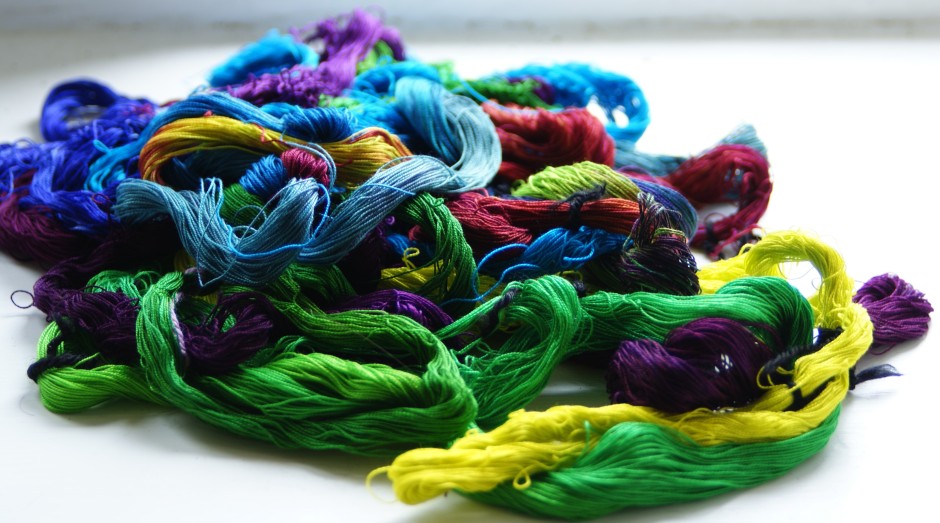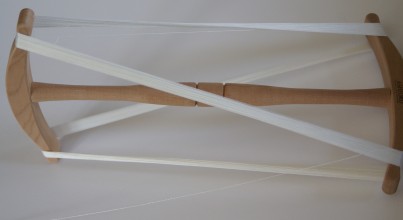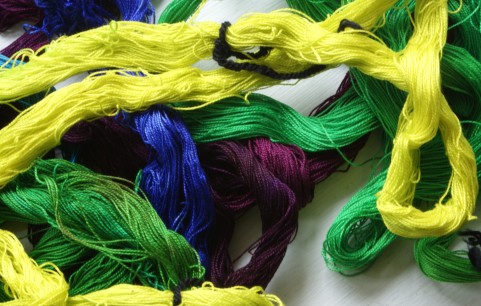Sod’s Law for Crafters says that, no matter how big your stash, you still will never have the right material for the project at hand. Having recently started weaving, that saying is more true than ever. All of my non-acrylic yarns are committed to projects and I don’t have quite the volume of silk I’d need for a decent sized warp.
That meant it was time to indulge myself in a bit of ‘necessity’ shopping. Shopping for weaving threads is quite an experience, particularly as a UK resident. ‘wc’, ‘nm’, ‘cc’ are all units you might see, as well as various fractions, weight per length and often, a complete absence of any useful information.

It doesn’t help that there are regional variations in the naming systems as well as the hilarity of trying to work out whether you’re using metric or imperial units for the weights and lengths as well. All of this makes for a real headache when you’re online shopping and there aren’t many good visual comparisons available for reference either, something I will try and address at some point. I really recommend trying to find the weight per length information (e.g. kg per m or lbs per inch) if you can as it is usually more informative than the naming.
After giving myself a bit of a headache, I ended up ordering a mixture of silk and cotton from Handweaver’s Studio, that have a really comprehensive range of weaving yarns. I can confirm that Handweaver’s Studios 2/16 is indeed the same weight as an American 16/2 and approximately the same weight as a laceweight yarn. They are a great supplier but their website is really unhelpful as you have to go to their catalogue pages to actually get much information on the products, rather than it being directly accessible on the product page where you need to be to buy the damned thing…

Variety is the spice of life and I do enjoy having a good colour pallet to choose from. However, as I wasn’t completely sure what colours I’d need, how much, what I was even going to do, I thought the best value for money would just be to buy a load of plain cotton and get to work with some Procion MX dyes.

I wound off ~ 1250 m skeins of Optical cotton ready for dyeing. All the guides say you’re supposed to scour cotton by boiling it up with soda ash. Now I will confess I don’t really wash my silk top beyond giving it a rinse before I dye it and I’ve never had any problems so because I’m lazy, I thought I’d see if I could get away without scouring the cotton before use as well. I decided to scour 8 out of the 10 skeins using the hot wash/soda ash method and then leave two just to pre-soak to see if there was an obvious difference in how predictable the dyeing was.

As I was going to do a black warp in 2/16 cotton, I really wanted vivid colours that wouldn’t get swallowed by the black. It was a struggle to resist the temptation to make highly variegated skeins too but I wanted subtler variations in mostly block colours to fit in with the weaving.

Working with skeins was refreshingly easy after my last top-dyeing marathon. I’d left the skeins to soak in the soda ash for nearly 24 hours and even dyeing with them relatively dry, I had great fun watching even the smallest drop of dye rapidly moving along the skein.


The colours all took fantastically on the cotton and there is no obvious difference in the colours on the scoured and non-scoured cottons. However, in contrast to the nice, quick dyeing process, the rinsing turned out to be a pain in the neck, with a seemingly infinite amount of dye haemorrhaging out of each skein. Even skeins that had relatively little dye, with large undyed areas seemed to be just as bad.


If you are lazy and have no health and safety qualms about it, I highly recommend just making a mini-washing line in your shower and just leaving the shower to deal with it on your behalf. Cotton also has no qualms about being abused with hot water either, though your electricity bill and environmental credentials might!



Some of the purples looked incredibly dark until they had completely dried and there might have been a spot of ‘accidental’ space-dyeing going on but I’m really pleased with how they’ve come out, perhaps with the exception of what has been nicknamed the ‘nuclear yellow’ skein. That’s Kemtex ‘Acid Lemon’ with a bit of green contamination and I think might be looking for a slightly less lurid base yellow for mixing.

This was such a fun project and the mercized cotton is really soft and kept its nice sheen after dyeing as well. I have got around to making the warp for what will hopefully be a set of 10 samplers but it is currently at home on the floor rather than the loom… Next job on the list!



Such luscious colours!
LikeLiked by 1 person
Fantastic! Love all the colors.
LikeLiked by 1 person
They all look really good but I sympathize with the washout having been there done that but with fabric and t-shirts instead of cotton thread. My method is usually to just leave the stuff sitting in a hot sink for a couple of hours, drain and repeat until the water turns clear (this after an initial washout in the machine). The bleed out is caused by excess dye that didn’t attach to the cotton. Hot water helps to loosen the excess dye, cold water doesn’t work as well but you probably know all of this anyway 🙂
It’s easier working with fabric and t-shirts because you can throw those in the washer for a rinse out. The cotton thread must be harder to deal with. I wonder if you had tiny mesh laundry bags that would restrict the movement of the cotton threads if you could then toss them into the washing machine to help out with the rinse-out?
Karen
LikeLiked by 1 person
Thanks for the really helpful reply. Excess dye is the only thing I guess it could be I’m just really surprised by the amounts that seem to be coming out (though as I used very saturated dye stocks that might mean the run-off looks worse than it is.)
I’m a bit nervous about putting them in the washing machine as mine is a communal one and if anything goes wrong I might not be very popular but I think mesh bags and lots and lots of ties would be just fine for the skeins, particularly as cotton isn’t going to damage too easily. It’s reassuring to know I’m not the only one getting huge amounts of run off!
LikeLike
The theory behind it is that there are only so many sites (where the molecules attach) where the dye can attach so if you have a really saturated dye stock then odds are you’re going to get some run-off from the dye molecules that don’t attach. You need the sodium carbonate for the MX dyes to have that chain reaction with the cotton. Some people will soak their cotton for about 30 minutes for the sodium carbonate to be fully absorbed, others add the sodium carbonate to the dye solution. Personally I don’t do this because once you add the dye to the sodium carbonate you’ve only got a specific amount of time before the dye exhausts. It all depends on the effect you’re after.
I can understand about putting the dye in the communal washing machine for sure. One thing about tying up the cotton, don’t tie to tightly or you’ll provide a resist and the dye won’t penetrate under the tie.
I’ve used the Procion MX dyes on wool (with an acid to bond) and I’m always surprised at how much dye rinses out afterwards. I probably should weigh the dye according to weight of fabric (yarn) to avoid the run-off but I’m too lazy and just slosh the stuff in then curse afterwards when I’m constantly trying to wash the stuff out. The acid dyes on wool work like a charm but there’s run-off there as well.
Karen
LikeLiked by 1 person
I’ve never found the run off with acid dyes to be nearly as bad (at least with silk) but I follow your line of thinking on the can’t really be bothered to weigh exact amounts. I also pre-soak my fibres because I don’t want the ticking clock running on my dyes! It’s good incentive to keep playing though, I do want to make some more cottons to weave with and experiment with trying to make some paler colours (for a change!) as well.
LikeLiked by 1 person
WOW – I have so enjoyed reading your post. It has been ages since I have played with my dyes and you are making me want to go and experiment. No time at present though – moo! I love the gorgeous colours that you have chosen. Cannot wait to see the next stages of your creation x.
LikeLiked by 1 person
That’s such a shame – hope you get some time soon! There’s never enough time for playing with dyes, it’s just so much fun. I’m the process of doing some DIY for stage 2 of this project, so hopefully I’ll actually be weaving soon.
LikeLike
Wow, what a helpful post!
I have always avoided dying mercerized cotton thinking it might not take the dyes as well as wool, but obviously I just was using the wrong dyes.
I have only ever used plant dyes (because I am a scardy-cat) but now I am inspired to learn how to handle Procion MX. What a beautiful colourful warp and woof you will have!
Love,
Baba StringThings
LikeLiked by 1 person
Apparently mercerized cotton is supposed to take the dyes very differently but all of my colours were very reproducible from how they looked on the silk top and, apart from the purples looking very dark until they dried, all was well in the end. Plant dyes are way harder than Procion MX ones, which (if you aren’t going to obsess over dissolving every last bit of dye) you can prepare in about 30 seconds and give awesome colours. The only thing to watch out for is to try not to handle the soda ash too much, I’ve not had any issues personally but it is an irritant. Look forward to seeing your adventures!
LikeLiked by 1 person
It’s absolutely on my to-do list now! ❤
LikeLiked by 1 person
I have always admired those that dye and weave. I don’t know the proper terms for these things as I don’t do them. But…WOW the colors are just beautiful. Whatever you decide to use these for are going to be gorgeous. I really do admire you. Much luck in your endeavors.
LikeLiked by 1 person
Thank you! I’m hoping the warp will end up on the loom for this at some point this century…
LikeLike